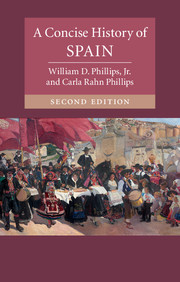Book contents
- Frontmatter
- Contents
- List of illustrations
- List of maps
- Preface
- Note on the second edition
- 1 The land and its early inhabitants
- 2 Ancient legacies
- 3 Diversity in medieval Spain
- 4 The rise of Spain to international prominence
- 5 Spain as the first global empire
- 6 Toward modernity: From the Napoleonic invasion to Alfonso XIII
- 7 The struggle for the Spanish soul: Republic, civil war, and dictatorship
- 8 New Spain, new Spaniards: European, democratic, and multicultural
- Chronology and rulers
- Guide to further information
- Index
- Cambridge Concise Histories
4 - The rise of Spain to international prominence
Published online by Cambridge University Press: 05 December 2015
- Frontmatter
- Contents
- List of illustrations
- List of maps
- Preface
- Note on the second edition
- 1 The land and its early inhabitants
- 2 Ancient legacies
- 3 Diversity in medieval Spain
- 4 The rise of Spain to international prominence
- 5 Spain as the first global empire
- 6 Toward modernity: From the Napoleonic invasion to Alfonso XIII
- 7 The struggle for the Spanish soul: Republic, civil war, and dictatorship
- 8 New Spain, new Spaniards: European, democratic, and multicultural
- Chronology and rulers
- Guide to further information
- Index
- Cambridge Concise Histories
Summary
The modern geography of the Iberian Peninsula, which Spain shares with Portugal, seems so familiar that we might assume that the two countries were destined to evolve toward their modern borders. If we trace the late medieval history of the peninsula, however, there was no inevitability about the process. Castile might have amalgamated with Portugal, a possibility that informed the contingency plans of a succession of monarchs in both Spain and Portugal. And, instead of the amalgamation of Castile and Aragon in the late fifteenth century, those two kingdoms might have remained separate. In short, depending on the vagaries of dynastic politics and demographic realities, the Iberian Peninsula might have had a very different configuration from the familiar borders we recognize today.
To understand why events unfolded as they did requires recognition of the contingent nature of events in every aspect of the late medieval history of Spain. For example, in diplomacy, each of the Iberian kingdoms looked outward to strengthen diplomatic ties with various parts of Mediterranean and Atlantic Europe, as well as with North Africa, and those ties inevitably affected internal politics as well. Economically, growth in the Spanish kingdoms in the fourteenth and fifteenth centuries – based on stock-raising, agriculture, and manufacturing – supported an expanding export trade that benefited from Spain's location at the nexus of Mediterranean and Atlantic Europe. Over the course of the late Middle Ages, that economic growth prepared Spain to become the first world power.
Paradoxically, economic development took place against a background of enormous upheaval. The Black Death of the mid fourteenth century, in addition to causing a major demographic decline, also had widespread effects on Spanish economy and society. With a smaller population and fewer available workers, the herding industry, with low requirements for labor, could take advantage of the vast grazing lands available throughout the peninsula, at the same time that agricultural production declined. The Black Death also affected politics in ways both subtle and immediate. One of the most dramatic events was the death of King Alfonso XI of Castile in 1350, stricken by the epidemic as he besieged Muslim Gibraltar.
Alfonso was the only reigning monarch in Europe killed by the Black Death, and his demise set the stage for a struggle and eventually a long civil war between his legitimate heir and his bastard son, Enrique of Trastámara.
- Type
- Chapter
- Information
- A Concise History of Spain , pp. 107 - 175Publisher: Cambridge University PressPrint publication year: 2015

